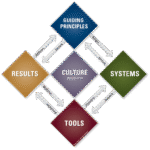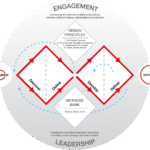
In a world that demands constant innovation, creativity has evolved from a desirable trait into an essential skill. But can something as ethereal as creativity be measured? Dr. Ellis Paul Torrance, a pioneering psychologist and researcher, believed so. From his conviction, the Torrance Tests of Creative Thinking (TTCT), commonly known as the Torrance Test, were born in the 1960s (Kim, 2006).
This article is a complete and definitive guide. Here, we will not only explore what the Torrance Test of Creative Thinking is, but we will also break down its components, understand how the Torrance Test is scored, and offer examples and practice questions. We will analyze its validity, its practical applications for educators and parents, and its surprising relevance in the age of artificial intelligence.
What is the Torrance Test?
The Torrance Tests are a set of assessments that have become the gold standard for measuring creative thinking potential, having been used for over six decades worldwide.
To understand the Torrance Tests of Creative Thinking (TTCT), we must first understand its creator. E. Paul Torrance didn’t just want to evaluate creativity; he wanted to understand and foster the qualities that help people express it, with the tests serving as tools for improvement (Kim, 2006). His “Creative Manifesto for Children” is a call to action for educators and parents. Principles like “Don’t be afraid to fall in love with something and pursue it with intensity” or “Learn to walk alone” are the philosophical foundation of his work. Torrance saw creativity as an innate ability that the educational system often suppresses. His tests, therefore, were not designed to label, but to identify and nurture that potential.
Beyond measurement: Identifying creative potential in children and adults
The main objective of the Torrance creativity test is to provide educators with a practical guide to identify and develop the creative talents of students (Alabbasi et al., 2022); in areas such as divergent thinking and the ability to generate multiple solutions to a problem.
The Torrance test is widely used to identify students for gifted programs (Torrance Test for gifted), but its scope is much broader. It helps individuals understand their own creative strengths, providing a vocabulary to describe their way of thinking. For an educator, it is a tool to adapt teaching; for a parent, a guide to stimulate their child’s curiosity.
The relevance of the TTCT in the Age of Artificial Intelligence
Recently, a new field of application has emerged: “AI creativity tests.” Researchers are using adapted versions of the TTCT to measure the creativity of large language models (LLMs), such as GPT (Zhao et al., 2025), or other artificial intelligence models. A notable study, “Pushing GPT’s Creativity to Its Limits,” conducted by Goes et al. (2023), used these tests to explore the creative capabilities of AI; meanwhile, the results of the research by Guzik et al. (2023) indicated that ChatGPT scored within the top 1% for originality and fluency.
On the other hand, Ruzieva (2025) studied the impact of generative artificial intelligence (AI) on student creativity in higher education and found that students who used AI tools like ChatGPT in their creative tasks showed a 15.2% improvement in the Torrance Tests of Creative Thinking (TTCT) scores compared to the control group.
The results of the cited studies not only open a new front of research into the creativity of Large Language Models but also compel us to redefine what we consider “human” creative thought, highlighting the continued relevance and adaptability of the TTCT.
Breaking down the Torrance Tests (TTCT): Key components and activities
The TTCT is not a single exam but a battery of tests divided into two main formats: the Torrance Figural Test (non-verbal thinking) and the Torrance Verbal Test (language-based thinking). Both are designed to assess different facets of creativity under time pressure; however, Alabbasi et al. (2022) recommend using the figural form if resources are limited, as it is more culturally fair due to the reduced need for writing.
The Torrance Figural test: Thinking with pictures
This section evaluates creativity through visual responses and consists of three activities:
- Activity 1: Picture construction: The individual is given an abstract shape (like a jelly bean) and asked to use it as a starting point to create a picture. The goal is for the shape to be an integral part of the final image, not just an add-on.
- Activity 2: Picture completion / Incomplete figures: Several incomplete figures are presented, and the participant is asked to complete them to create interesting and meaningful objects or scenes.
- Activity 3: Repeated figures (Lines/circles): The participant receives a page with multiple identical figures (circles, parallel lines) and must convert them into as many different images as possible.
The Torrance Verbal test: Playing with words
This section measures creativity through written and oral responses. It includes activities such as:
- Activity 1: Ask-and-guess: A complex picture is shown, and the participant is asked to write down all the questions they can think of to understand what is happening, the possible causes, and the consequences.
- Activity 2: Product improvement: A common object (like a stuffed toy) is presented, and the participant is asked to suggest clever, interesting, and unusual ways to improve it.
- Activity 3: Unusual uses: Similar to the Alternative Uses Test, the participant is asked to list as many interesting and unusual uses as possible for a common object, like a cardboard box.
- Activity 4: Just suppose: A hypothetical and improbable situation is posed (e.g., “Just suppose clouds had strings attached to them which hang down to the ground”), and the participant is asked to imagine and describe all the possible consequences.
How is the Torrance Test scored? The criteria that define creative thinking
Understanding how the Torrance Test is scored is crucial to appreciating its value. It is not about “right” or “wrong,” but about evaluating the quality and quantity of creative thought. In this regard, Alabbasi et al. (2022) highlighted that although no special training is needed to administer the TTCT, specific training is required to score it reliably.
The scoring criteria for the Torrance Test are based on several norm-referenced indicators and a set of creative strengths. Below, we describe five key scoring indicators:
The 5 key scoring indicators
- Fluency: The ability to produce a large number of relevant ideas or responses. It is a measure of quantity. How many uses for a cardboard box can you name?
- Originality: The ability to produce rare, unique, and statistically infrequent ideas. A response given by only 5% or less of the population is considered original.
- Elaboration: The ability to develop and embellish an idea with details. It’s not just the idea, but the richness with which it is described.
- Flexibility: The ability to generate a variety of ideas or responses across different categories. If for “uses of a box” you only mention types of containers (for shoes, for hats), your flexibility is low. If you mention a shelter, a toy car, and art material, your flexibility is high.
- Resistance to Premature Closure: Specific to the figural test, this measures a person’s tendency not to “close” the incomplete figures in the quickest and simplest way possible, instead remaining “open” to more complex ideas.
The 13 measured creative strengths
In addition to the norm-referenced scores, the TTCT identifies 13 creative strengths that provide a richer profile. Two of the most important are:
- Abstractness of titles: On the figural test, this assesses the ability to go beyond the obvious when naming drawings. A title like “Car” is literal; “Journey into Imagination” is abstract.
- Resistance to premature closure: As mentioned, this is both a score and a key strength, indicating cognitive sophistication.
Other strengths include Emotional Expression, Richness of Imagery, Humor, Fantasy, and Combination of Ideas, among others.
Interpretation of results: From raw scores to percentile anks
The raw scores for each criterion (the total number of responses for fluency, for example) are converted into Torrance standard scores and Torrance percentile ranks. This allows for the comparison of an individual’s performance with a normative group of the same age or grade level. A percentile rank of 85 means the person scored as well as or better than 85% of the people in their reference group. The key is to interpret the results of the Torrance Tests not as a fixed measure of intelligence, but as a snapshot of creative potential at a given moment.
Preparing for the Torrance Test: Examples and practice questions
Although creativity cannot be “taught” overnight, familiarity with the test format can reduce anxiety and allow true creative potential to shine. Therefore, looking for Torrance practice tests or open-access questions to practice is a common strategy. However, I must warn you that the research findings of Sumners et al. (2024) suggest that explicit training on how to score the Torrance Tests of Creative Thinking–Figural (TTCT-F) is not beneficial for test performance.
Why practice? Familiarization vs. creativity “training”
The goal of practice is not to memorize answers but to understand the task. It is similar to doing warm-up exercises before sports. Activities like “creativity warm-ups” can help get into a more flexible and open state of mind. Practice helps one understand that quantity (fluency), originality, and detail (elaboration) are valued.
Examples from the Torrance Figural Test
- Picture completion example: Imagine a “V” shaped line. What could you draw? An ice cream cone is a common response. A rocket taking off or the nose of a cartoon character are more elaborate. A pair of dancer’s legs seen from above is more original.
- Repeated figures example: With a page full of circles, how many things can you make? A smiley face, a ball, an orange (low flexibility). A clock, a car wheel, a bubble, a planet, an eye (high flexibility).
Examples from the Torrance Verbal Test
- Unusual uses example: “List unusual uses for a tire.”
- Response with low originality: A swing.
- Response with higher originality: Cut it into strips to make sandals, use it as a planter for a garden, fill it with cement to make a base for an umbrella, use it as part of an obstacle course.
- “Just suppose” example: “Just suppose people could instantly teleport to any place they have seen before.”
- Consequences: The transportation industry (cars, planes) would collapse. Tourism would change drastically. The concept of “living near work” would disappear. Espionage would be easier. Long-distance relationships would be different.
The academic debate: Validity, reliability, and relevance of the TTCT in the 21st Century
No psychometric test is without debate. The discussion around the “validity of the Torrance Test” and the “relevance of the TTCT” is fundamental to its responsible use.
Arguments in favor: Longitudinal studies and predictive power
The greatest strength of the TTCT comes from the “Torrance longitudinal studies.” Torrance followed his subjects for decades and found that TTCT scores in childhood were significant predictors of creative achievements in adulthood, such as patents, publications, founding businesses, and other accolades. Proponents, such as in the article “Proven Reliability and Validity of the Torrance Tests of Creative Thinking (TTCT),” argue that this predictive evidence is solid and refutes many of the criticisms.
Criticisms and questions: Do they really measure “real” creativity?
Critics, like those in the “How Divergent Thinking Tests Mislead Us” debate (Baer, 2011), question whether the timed and artificial tasks of the test reflect real-world creativity, which often requires incubation, collaboration, and deep knowledge. For their part, Almeida et al. (2008) suggest that the TTCT tasks may not be the most appropriate stimuli to assess creativity based on the processes of fluency, flexibility, and originality in young populations.
The question of domain specificity: Is creativity general or specific?
A central point in creativity assessment research is the debate over the domain specificity of creativity. Is a person creative in general, or is their creativity specific to a domain (art, science, business)? The TTCT is based on the idea of a general creativity factor, whereas many modern researchers argue that to be creatively successful in a field, one needs deep knowledge of that field.
Practical applications: What is the Torrance Test used for?
Despite the debates, the TTCT remains a valuable tool in various fields.
Identification of gifted and talented students
Perhaps its best-known use is in gifted education. Traditional IQ tests often fail to identify highly creative students who may not be the highest academic performers. The TTCT offers a complementary view, identifying a different kind of talent. For example, by using the Torrance test, Acar et al. (2023) found that individuals with high creative potential tend to ask more open-ended questions, which is a robust indicator of their creativity.
A guide for educators: Fostering creativity in the classroom
The TTCT framework can guide classroom teaching, integrated into lesson plans and warm-up activities to foster creative thinking (Alabbasi et al., 2022). By understanding the components of creativity (fluency, originality, etc.), teachers can design activities that deliberately encourage them. For instance, Trisnayanti et al. (2019) developed a Torrance Test Creativity Thinking (TTCT) approach in science learning and concluded that the instrument helps improve the quality of learning by revealing the creativity of different students. This fulfills Torrance’s mission regarding the role of teachers in fostering creativity and provides a framework for teaching creativity in the classroom.
A tool for parents: How to support creative development at home
Parents can use the principles of the TTCT without needing to administer the test formally. Encouraging curiosity, asking open-ended questions (“What else could you do with that?”), celebrating unusual ideas, and allowing for unstructured play are direct ways to nurture the skills measured by the test.
Conclusion: The Torrance Test as a tool, not a final verdict
The Torrance Tests of Creative Thinking are much more than a simple score. They are a system for understanding, discussing, and fostering one of the most important human skills. They have stood the test of time, adapting from identifying gifted children to assessing artificial intelligence.
Summary of key points:
- The TTCT measures creative thinking potential through verbal and figural tasks.
- It scores based on criteria like fluency, originality, elaboration, and flexibility.
- Its validity is supported by longitudinal studies that correlate scores with real-life creative achievements.
- It is a fundamental tool for educators and parents seeking to foster creativity.
Our recommendation:
Let’s view the Torrance Tests not as a definitive label, but as a starting point. It is a diagnostic tool that can reveal hidden strengths and offer a language for cultivating potential. The true lesson from Torrance’s legacy lies not in the score, but in the celebration and active encouragement of curiosity, originality, and the courage to think differently.
Frequently Asked Questions (FAQ) about the Torrance Tests of Creative Thinking
Can you find the Torrance creativity test online for free?
No. The official TTCT is a copyrighted psychometric instrument that must be administered and scored by qualified professionals. What you can find online are examples, practice questions, and unofficial tests inspired by the TTCT, which are useful for familiarization but do not provide a valid score.
What is the main difference between the figural and verbal tests?
The difference lies in the medium of expression. The Figural Test assesses creativity through drawing and visual interpretation, measuring skills like visual imagination and the ability to see spatial relationships. The Verbal Test assesses creativity through words, measuring skills like semantic fluency and the ability to construct narratives and hypotheses.
At what age can the test be administered?
The TTCT is designed to be administered to individuals from kindergarten through adulthood. Different forms and norms appropriate for each age and grade level are available.
How are the results of the Torrance test interpreted?
Results are interpreted by comparing an individual’s scores to a normative group. Percentile ranks and standard scores are provided for each criterion (fluency, originality, etc.). A complete interpretation also considers the 13 creative strengths to create a detailed profile of a person’s thinking tendencies, rather than a single “creativity score.”
Is the TTCT the only way to measure creativity?
No. Although the TTCT is the most widely used and studied test for divergent thinking, other assessments exist. Some measure different aspects, such as creative personality or past creative achievements. The TTCT remains the gold standard for measuring creative thinking potential, but a comprehensive assessment of a person’s creativity often benefits from multiple sources of information.
References
Acar, S., Berthiaume, K., & Johnson, R. (2023). What kind of questions do creative people ask? Journal of Creativity, 33(3), 100062. https://doi.org/10.1016/j.yjoc.2023.100062
Alabbasi, A. M., Paek, S. H., Kim, D., & Cramond, B. (2022). What do educators need to know about the Torrance Tests of Creative Thinking: A comprehensive review. Frontiers in Psychology, 13, 1000385. https://doi.org/10.3389/fpsyg.2022.1000385
Almeida, L. S., Prieto, L. P., Ferrando, M., Oliveira, E., & Ferrándiz, C. (2008). Torrance Test of Creative Thinking: The question of its construct validity. Thinking skills and creativity, 3(1), 53-58.
Baer, J. (2011). How divergent thinking tests mislead us: Are the Torrance Tests still relevant in the 21st century? The Division 10 debate. Psychology of Aesthetics, Creativity, and the Arts, 5(4), 309–313. https://doi.org/10.1037/a0025210
Goes, F., Volpe, M., Sawicki, P., Grzes, M., & Watson, J. (2023). Pushing GPT’s Creativity to Its Limits: Alternative Uses and Torrance Tests.
Guzik, E. E., Byrge, C., & Gilde, C. (2023). The originality of machines: AI takes the Torrance Test. Journal of Creativity, 33(3), 100065. https://doi.org/10.1016/j.yjoc.2023.100065
Kim, K. H. (2006). Can we trust creativity tests? A review of the Torrance Tests of Creative Thinking (TTCT). Creativity research journal, 18(1), 3-14.
Ruzieva, M. (2025). Innovative learning through AI: Nurturing creativity in the classroom. Modern American Journal of Linguistics, Education, and Pedagogy, 1(2), 520-534.
Sumners, S. E., Paek, S. H., & Cramond, B. (2024). Are Creativity Tests Vulnerable to Coaching? Creativity Research Journal, 1–8. https://doi.org/10.1080/10400419.2024.2335780
Trisnayanti, Y., Khoiri, A., Miterianifa, & Ayu, H. D. (2019, December). Development of Torrance test creativity thinking (TTCT) instrument in science learning. In AIP Conference Proceedings (Vol. 2194, No. 1, p. 020129). AIP Publishing LLC.
Zhao, Y., Zhang, R., Li, W. et al. Assessing and Understanding Creativity in Large Language Models. Mach. Intell. Res. 22, 417–436 (2025). https://doi.org/10.1007/s11633-025-1546-4
Editor and founder of “Innovar o Morir” (‘Innovate or Die’). Milthon holds a Master’s degree in Science and Innovation Management from the Polytechnic University of Valencia, with postgraduate diplomas in Business Innovation (UPV) and Market-Oriented Innovation Management (UPCH-Universitat Leipzig). He has practical experience in innovation management, having led the Fisheries Innovation Unit of the National Program for Innovation in Fisheries and Aquaculture (PNIPA) and worked as a consultant on open innovation diagnostics and technology watch. He firmly believes in the power of innovation and creativity as drivers of change and development.





